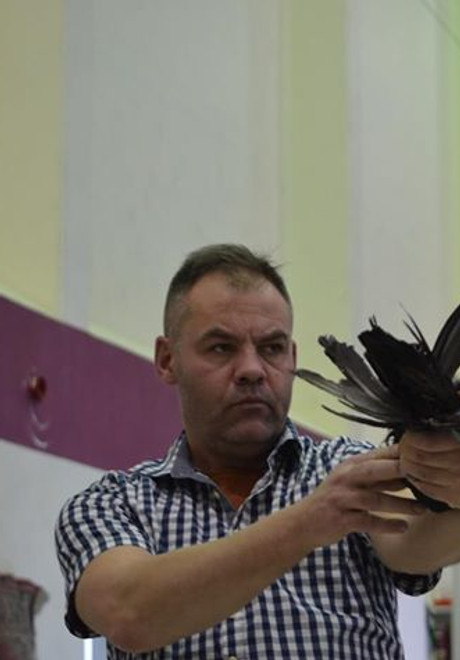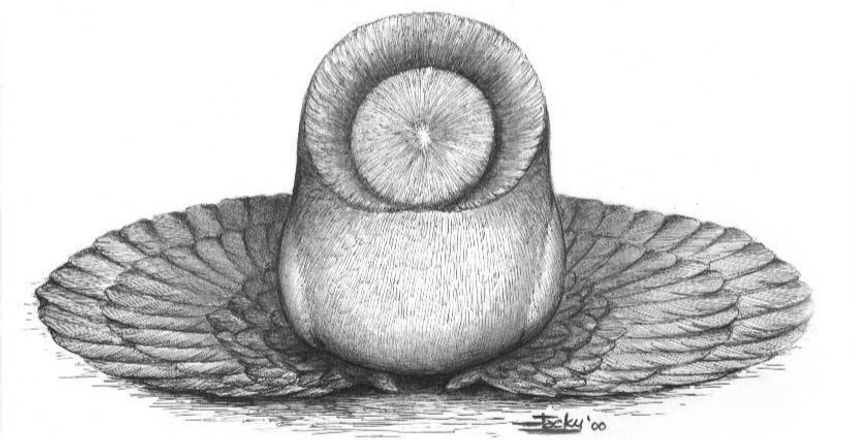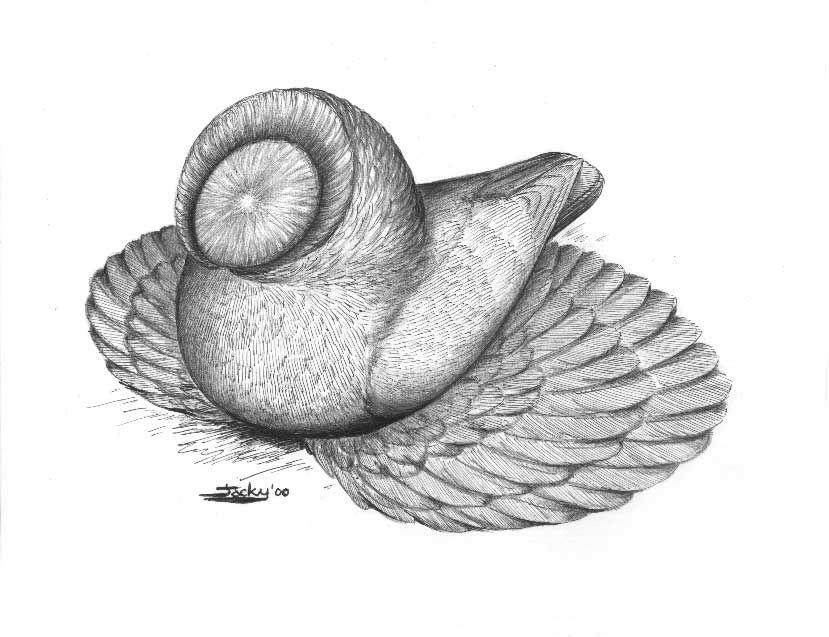
SELECTING STOCK TO BREED FROM
The other sections of this page offer advice on to manage your Bokharas to get the most pleasure out of them.
Now it is time for the serious stuff. Some will breed a breed a lifetime only to never produce anything worthy of an extra look. The same can be done in Bokharas.
If you think color and markings are crucial in determining the quality of Bokhara you are in the wrong breed.
If you think white top, yellow bald, almond, ash, full circle, bokharoo and a lot of other crap are crucial in determing the value of a Bokhara you are in the wrong breed
THE STANDARD
We have a standard. The value of Bokhara in a show is determined by how the bird visually compares to that standard.
The more the bird looks like the drawing below, the better a show bird it is. Anything not seen in this drawing is a fault. One thing does not compensate for another.
Feature judging is a major problem in Bokharas where judges tend to overlook some faults because a bird is particularly strong in other areas, maybe to the judge's personal like. This is not now it is meant to be and we must never stop discussing how we ensure judging is done to the standard. With more international focus on pigeon breeding and also on Bokharas ( Which I do like) we have also seen all kind strange agendas come into play - Asia and some Eastern Europeans placing value solely on parts of the Bokhara such as big roses, certain colors or massive pointy boots or Middle eastern countries featuring huge wrapping shells and forgetting about so much else. Having bred Bokharas for 30 years such things hurt and do make you worried why this "new wave" of breeders is actually in Bokharas and pigeons at all. I will never support non-standard judging and evaluating.
Never.


THE IBTC STANDARD
The standard we use was first drawn up around 1886 by the great pigeon author Robert Fulham and then top Bokhara breeder M.F. Smythe of Ireland.
It has been adjusted and updated in words over the years but apart from adding the wrap to the shell part of the standard in 1970, there has been no change of style to the desired bird. The wrap was added as breeding for a more compact, richer feathered bird simply caused the birds to develop this feature as they grew older and the circle-in-the-circle expression was greatly admired and appreciated. This is still so today.
The perfectly round, large and smooth rose is still where Bokharas both start and end. Anything else must match that rose.
Read the standard text below and visualize it, then do that over and over again....

GETTING STARTED
You will most likely like the rest of us start with a few random Bokharas that you could get your hands and if you are one of few who gets taken with a desire to perfection these wonderful birds you will be soon looking for improvements.
Let me say that none of the great Bokhara breeders got to where we are by buying new birds all at the time. We got there by patience and skilfull breeding of what we had, observing and learning from the birds and from the efforts of others.
You can buy the best birds, providing you got the money to do so but you can not buy your way to the top in the shows over any duration of time.
You can only breed yourself into the history books.
USEFUL STOCK
You want birds that will allow you to breed birds as close to the standard as possible.
In doing to so there are few things to avoid (some of these birds might be used wisely by an experienced breeder but will cause havoc if used as the base of the creating a Bokhara family)
- The rose
Avoid oval, droopy over the beak, thin and gappy roses.
- The neck
Avoid birds with long narrow necks.
- The shell
Avoid birds with hairy loose feather, birds
with very poor cup in the shell
- The Body
Avoid birds with very narrow shoulders and greatly lacking fullness in the chest, creating the appearance of a very long narrow Bokhara.
- The Station
Avoid birds which seems to station high, pay
attention to the legs. If you can see thru them
something is certainly wrong
If you can see the upside of both feet be
careful too, the feet of a good Bokhara will
be hidden in breast feather
- Plumage
Avoid birds with an overall thin appearance of a hairy feather. Wide strong feathers are very
essential in breeding quality Bokharas
- Wings
How will you breed a solid looking
deep wide bird if the wings are long
and narrow?
OBTAINING STOCK
Your budget to spend comes into play
You may not like to hear so but it is the reality. None of us give the birds away, especially not to newcomers where we do not know if the person will pay proper respect to the birds and their care.
Once you are a proven member of the Bokhara family things will change with most breeders but it will take some will and determination to get there on your behalf.
I have bred the Bokharas for 30 years and can surely say I have a family of birds. A family means they were selected to my understanding of the standard for years. My personal focus has always been the deep round chest and low station. I have selected for it over and over again. Why is this important?
Because it increases the breeding value for other people also. My birds simply breed this trait into other birds when they are crossed, because they have been purified for it for decades.
You should have the same goal in mind if you want to become a real breeder, a breeder whose birds will one day be used by others to improve their stock. Depending on where you live I have certain breeders in mind whose birds I think will be of great asset to you. You are welcome to contact me and get to know who they are. On a personal note and living in Europe I can say that are only 4-5 breeders here whose birds I would even consider using. All longtime breeders with families of Bokharas.
- A mediocre bird at from an inbred family producing winners over and over again will be a much more valuable breeder than a top bird that came from a random cross -
This is a fact. The crossing does not provide consistency in the offspring. Inbreeding does. Inbred birds, when crossed to other family inbreds can create positive traits not observed much in either parent. The random crossing of mediocre or poor quality birds is the fastest way to ensure you will get NOWHERE in breeding but backward.
Many are taken with the beauty of yellow, white. ash-colored, baldhead, etc. Bokharas. There is a reason all the top show breeders have lofts full of blues and blacks with the occasional good yellow or white or splash. The pretty colors can not be family breed and keep up the quality. The feather quality simply suffers due to the pigmentation or lack off of the feather.
Always base your Bokharas on blacks and blues if you want to be able to compete at the shows.
Good luck with making your gameplan.
 |  |
|---|
"KASPAR"
2004 EUROPEAN CHAMPION
"Kaspar" won the biggest Bokhara show ever in Europe with 230 Bokharas competing. His bloodline is behind many top quality Bokharas throughout the world today